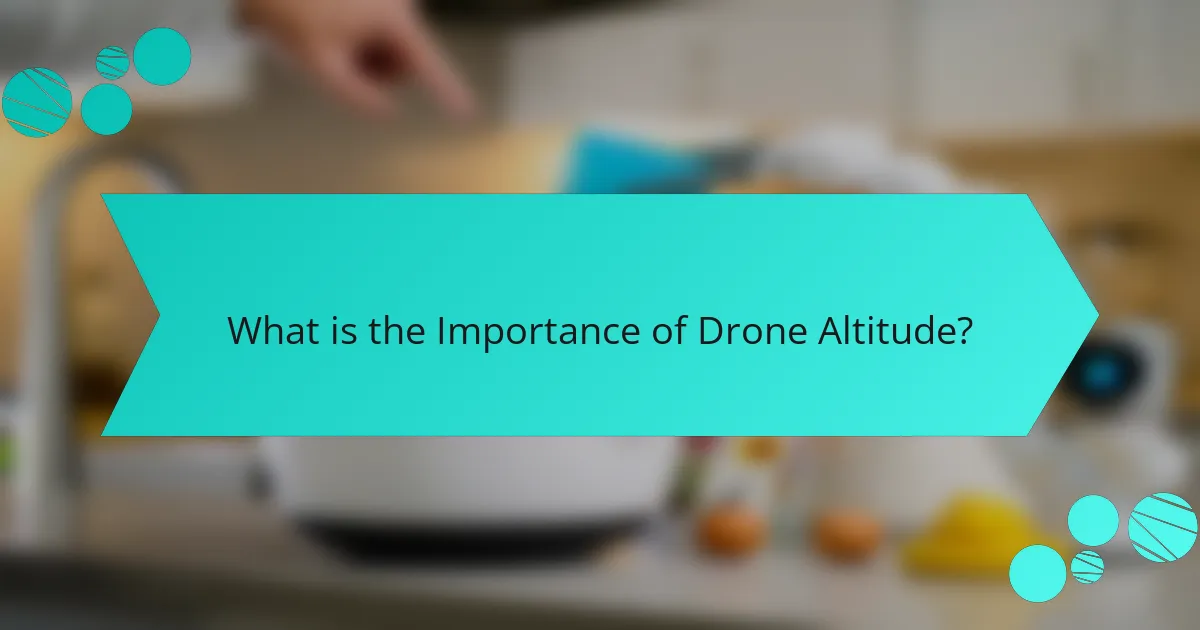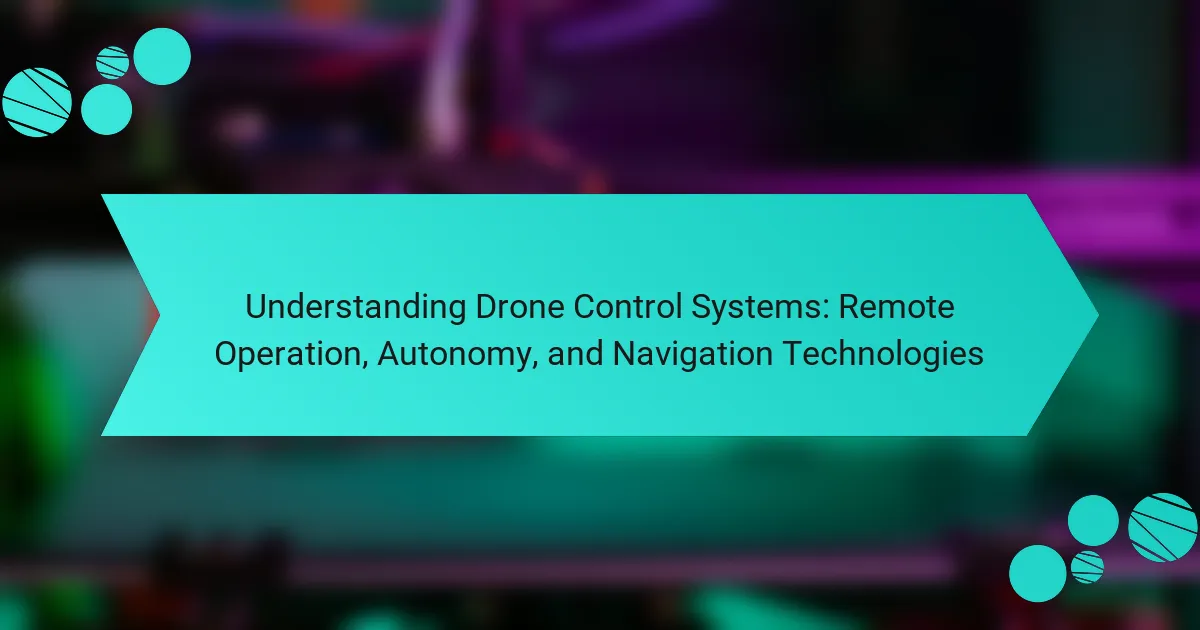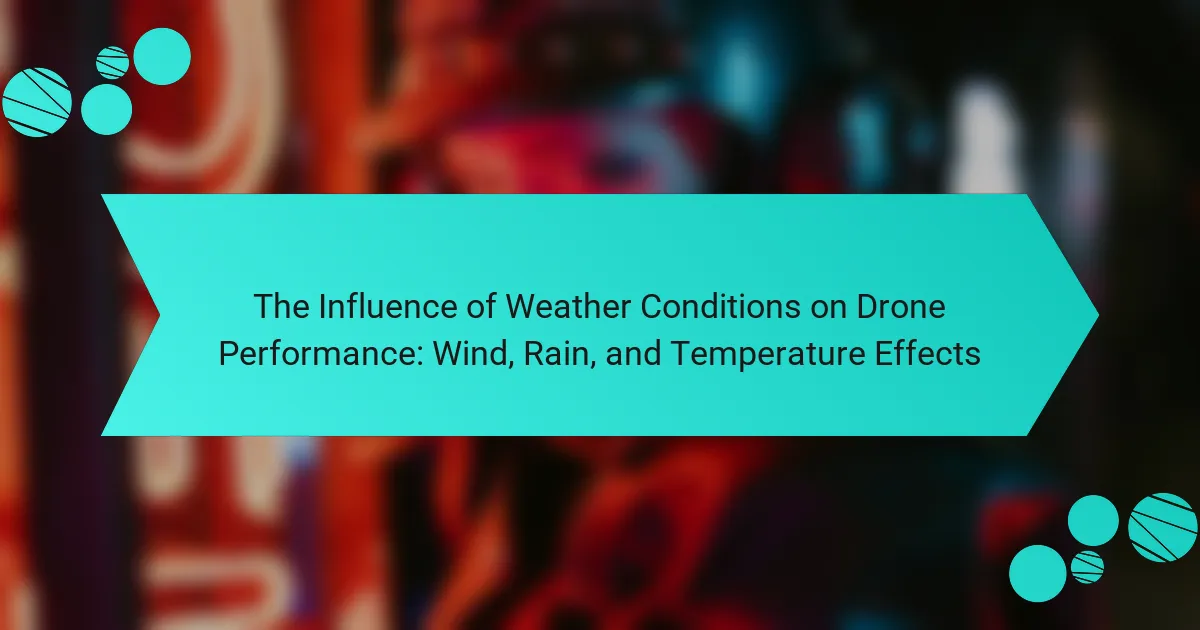
What is the Importance of Drone Altitude?
Drone altitude is crucial for ensuring optimal signal strength and performance during flight. Higher altitudes reduce obstacles that can interfere with signal transmission. This leads to greater range and improved communication between the drone and its controller. Additionally, flying at an appropriate altitude allows for better data collection in aerial surveys and inspections. Studies show that signal degradation occurs significantly at lower altitudes due to environmental factors. Thus, maintaining an ideal altitude is essential for maximizing the effectiveness of drone operations.
How does altitude affect drone performance?
Altitude significantly affects drone performance. As altitude increases, air density decreases. This reduction in air density impacts lift generation. Drones rely on rotor blades to generate lift. Less dense air means less lift for the same rotor speed. Consequently, drones may require higher rotor speeds to maintain altitude. This can lead to increased battery consumption. Additionally, high altitudes can affect the drone’s GPS signal. A weaker GPS signal can lead to reduced stability and control. Studies show that drones may struggle to operate effectively above 10,000 feet. This is due to both lift and battery efficiency challenges.
What are the key performance metrics influenced by altitude?
Key performance metrics influenced by altitude include signal strength, battery life, and flight stability. As altitude increases, signal strength often decreases due to the increased distance from the transmitter. This can lead to reduced control and data transmission quality. Battery life is also affected; higher altitudes may require more power to maintain stability against wind resistance. Flight stability can diminish at higher altitudes due to thinner air, impacting lift and control. Research indicates that these metrics are critical for optimal drone operation.
How does altitude impact drone stability and control?
Altitude significantly impacts drone stability and control. Higher altitudes result in thinner air, which affects lift generation. Drones rely on rotor blades to create lift through air density. As altitude increases, air density decreases, leading to reduced lift. This can cause drones to struggle with maintaining altitude and stability. Moreover, wind patterns change with altitude, potentially introducing turbulence. Turbulent air can lead to erratic drone movements. Additionally, higher altitudes may affect the drone’s battery performance due to temperature variations. These factors collectively influence a drone’s ability to maneuver effectively and maintain a steady flight path.
Why is signal strength critical for drones?
Signal strength is critical for drones because it directly impacts communication and control. Strong signal strength ensures reliable transmission of data between the drone and its operator. This reliability is essential for maintaining control, especially during complex maneuvers or in challenging environments. Weak signals can lead to loss of control, resulting in crashes or accidents. Research indicates that drones operating at higher altitudes may experience reduced signal strength due to increased distance from the controller. According to a study by the Federal Aviation Administration, maintaining optimal signal strength is vital for safe drone operations. Thus, effective signal management is crucial for enhancing drone performance and safety.
What role does altitude play in signal transmission?
Altitude significantly affects signal transmission. Higher altitudes can enhance line-of-sight communication. This is critical for drone operations, as obstructions are minimized. Signal strength often improves with increased altitude due to reduced interference. For instance, radio waves travel better in less dense air. Research indicates that signal degradation occurs at lower elevations due to buildings and terrain. Effective drone operation requires optimal altitude for reliable signal strength. Therefore, altitude is a key factor in ensuring effective communication in aerial applications.
How does signal strength affect drone operation and safety?
Signal strength directly affects drone operation and safety. Strong signal strength ensures stable communication between the drone and its controller. This stability is crucial for maintaining control during flight. Weak signal strength can lead to loss of control, causing the drone to drift or crash. According to a study by the Federal Aviation Administration, signal loss can increase the risk of accidents significantly. Maintaining optimal signal strength is essential for safe navigation and operation. Additionally, strong signals allow for real-time data transmission, enhancing situational awareness for the operator. Therefore, ensuring robust signal strength is vital for safe drone operation.
What are the environmental factors affecting drone altitude?
Environmental factors affecting drone altitude include temperature, humidity, air pressure, and wind conditions. Temperature influences air density, which affects lift. Higher temperatures reduce air density, leading to lower lift capacity. Humidity alters air density as well; increased humidity can decrease lift. Air pressure impacts drone performance; lower pressure at higher altitudes reduces lift. Wind conditions, especially strong gusts, can cause altitude fluctuations and affect stability. These factors collectively influence a drone’s ability to maintain or adjust altitude effectively.
How do weather conditions influence optimal flying altitude?
Weather conditions significantly influence optimal flying altitude for drones. Factors such as wind speed, temperature, and humidity play crucial roles. High winds can require lower altitudes to maintain stability and control. Conversely, warmer temperatures can lead to reduced air density, affecting lift and performance at higher altitudes. Additionally, humidity can influence signal strength and battery efficiency. For instance, flying in high humidity may decrease signal clarity, necessitating adjustments in altitude. Therefore, pilots must consider these weather elements to ensure safe and efficient drone operation.
What geographical features should be considered when determining altitude?
When determining altitude, consider geographical features such as mountains, valleys, and bodies of water. Mountains significantly affect altitude due to their height. Valleys can create lower altitude areas, impacting signal propagation. Bodies of water can influence humidity and temperature, affecting drone performance at different altitudes. Additionally, urban structures can create obstacles that influence altitude decisions. These features play a critical role in the overall effectiveness of drone operations.
How can understanding altitude improve drone operations?
Understanding altitude can significantly enhance drone operations. Altitude affects signal strength, battery life, and flight stability. Higher altitudes may reduce signal interference from obstacles. This leads to more reliable communication between the drone and the operator. Additionally, flying at optimal altitudes can improve battery efficiency. Research indicates that drones can experience increased lift and reduced drag at specific altitudes. This results in longer flight times and better performance. Furthermore, understanding altitude helps in avoiding restricted airspaces and obstacles. This knowledge is crucial for safe and effective drone missions.
What strategies can enhance signal strength at various altitudes?
Increasing signal strength at various altitudes can be achieved through several strategies. First, optimizing the drone’s antenna orientation can significantly improve reception. Proper alignment ensures maximum signal capture from the transmitter. Second, using high-gain antennas can enhance the signal strength. These antennas are designed to focus the signal, improving range and clarity.
Third, ensuring a clear line of sight between the drone and the controller is crucial. Obstacles can weaken the signal, so flying in open areas helps maintain strong connectivity. Fourth, utilizing signal boosters can amplify weak signals. These devices can be integrated into the drone’s system to enhance performance at higher altitudes.
Lastly, adjusting flight altitude based on terrain can also help. Flying above obstructions like buildings or trees can reduce interference. These strategies collectively contribute to improved signal strength for drones operating at various altitudes.
What are best practices for maintaining signal integrity while flying?
To maintain signal integrity while flying, ensure a clear line of sight between the drone and the controller. Obstacles can cause interference and signal loss. Use high-quality antennas designed for the specific frequency used. These antennas improve reception and transmission. Maintain optimal altitude to reduce interference from ground objects. Flying at higher altitudes often enhances signal strength. Regularly check for firmware updates on both the drone and controller. Updates can improve performance and reliability. Monitor signal strength indicators during flight. This helps in making real-time adjustments. Finally, avoid flying in areas with known electromagnetic interference. Such environments can disrupt signal integrity.
How can pilots adapt to changing altitude conditions during flight?
Pilots can adapt to changing altitude conditions during flight by adjusting their altitude settings and flight paths. They use altitude management systems to monitor and respond to changes. Real-time data from altimeters assists in maintaining the desired altitude. Pilots also communicate with air traffic control for guidance on altitude adjustments. Changes in weather can affect altitude, requiring pilots to make quick decisions. Continuous training prepares pilots for altitude variations. Utilizing autopilot systems can aid in maintaining stability during altitude changes. These practices ensure safety and optimal performance during flight.
What are common challenges faced with drone altitude and signal strength?
Drones often face challenges related to altitude and signal strength. One common issue is reduced signal quality at higher altitudes. As drones ascend, the distance from the transmitter increases, leading to potential signal degradation.
Interference from obstacles also poses a problem. Tall buildings or trees can obstruct signals, especially in urban environments. This interference can result in loss of control or video feed.
Another challenge is the impact of atmospheric conditions. Weather factors like rain, fog, or wind can affect signal transmission. These conditions can lead to erratic drone behavior or signal dropouts.
Lastly, battery performance may decline at higher altitudes. Reduced battery efficiency can limit flight time and control range. This is a critical factor for maintaining stable operations during flights.
What troubleshooting steps can be taken to resolve altitude-related issues?
To resolve altitude-related issues, first check the drone’s altitude settings. Ensure the drone is operating within its specified altitude range. Adjust the altitude if necessary to optimize signal strength. Monitor the signal quality during flight. If signal loss occurs, decrease altitude gradually. Use GPS and telemetry data to assess performance. Consider environmental factors like terrain and obstacles. Regularly update the drone’s firmware to improve performance. These steps can enhance signal reliability and overall flight performance.
How can pilots prepare for altitude-related signal loss?
Pilots can prepare for altitude-related signal loss by implementing several strategies. They should conduct thorough pre-flight checks of all communication and navigation equipment. This includes ensuring that backup systems are operational. Pilots must also familiarize themselves with the specific altitude limits of their drone models. Understanding these limits helps in planning flight paths. Utilizing ground control stations with strong signal capabilities is crucial. Maintaining visual line of sight during flight can aid in managing signal loss. Continuous monitoring of signal strength during operations allows for timely adjustments. Lastly, pilots should have contingency plans in place for signal loss scenarios. These preparations enhance safety and operational effectiveness.
What tips can enhance drone performance related to altitude and signal strength?
To enhance drone performance related to altitude and signal strength, maintain optimal altitude during flight. Drones typically perform best at mid-range altitudes, avoiding excessive height that can weaken signals. Ensure a clear line of sight between the drone and the remote controller. Obstacles like trees and buildings can obstruct signals. Utilize high-gain antennas to improve signal transmission and reception. These antennas can increase the effective range of communication. Regularly update the drone’s firmware to ensure improved performance and compatibility with various frequencies. Monitoring battery levels is crucial; low battery can reduce signal strength. Lastly, avoid flying in areas with high electromagnetic interference, as it can disrupt signal integrity.
The main entity of this article is drone altitude, which plays a critical role in determining signal strength and overall performance during flight. The article outlines how altitude affects various performance metrics, including lift generation, battery life, and flight stability, while emphasizing the importance of maintaining optimal altitude for effective signal transmission. Additionally, it discusses environmental factors, geographical features, and best practices for enhancing signal strength at different altitudes, as well as strategies for pilots to adapt to altitude-related challenges. Understanding these aspects is essential for maximizing drone operational efficiency and safety.



